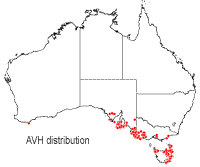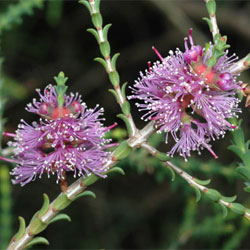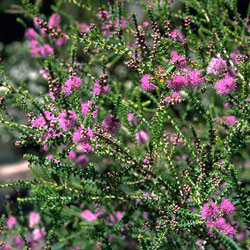Melaleuca gibbosa
Slender Honey-Myrtle
Melaleuca gibbosa is a member of the family Myrtaceae. Its common name is Slender Honey-Myrtle.
 M. gibbosa is a medium sized, dense rounded shrub 2 metres high to 2 metres wide with attractive foliage of small sessile ovate to obovate leaves. Leaves are aromatic when crushed. In Spring and early Summer it bursts into small dainty mauve to pink flowers which fade to white. In the wild it is found along the coast South Australia, Kangaroo Island, Victoria, Tasmania and Flinders Island. It is found in heath land in swampy areas and often over limestone.
M. gibbosa is a medium sized, dense rounded shrub 2 metres high to 2 metres wide with attractive foliage of small sessile ovate to obovate leaves. Leaves are aromatic when crushed. In Spring and early Summer it bursts into small dainty mauve to pink flowers which fade to white. In the wild it is found along the coast South Australia, Kangaroo Island, Victoria, Tasmania and Flinders Island. It is found in heath land in swampy areas and often over limestone.
M. gibbosa bark is grey and hard. The small leaves are ovate to obovate, sessile and blunt and arranged in opposite pairs with each pair of leaves at right angles to each other (known as decussate). Flowers occur in up to 10 pairs per spike and have numerous stamens. The flask-shaped fruits are woody and become embedded in the stem. Seeds are retained in fruiting capsules.
This plant is adaptable and easily grown in most soils in temperate areas of moderate to high rainfall. It is drought hardy, frost resistant and tolerates waterlogging. M. gibbosa can be grown from seed and seeds require no treatment before sowing. Seed is easy to collect and is best collected from fruit capsules which are 1 to 2 years old. After collecting seed, place into a non-airtight container. Sow thinly and germination takes about 14 days approximately. It can also be grown from semi hard wood cuttings taken in December to March. Use a rooting hormone such as Clonax gel purple 2000/IBA to establish cutting. Plant out in full sun to part shade. M. gibbosa is basically a low maintenance plant but you can manage shape and size with regular light pruning.
M. gibbosa has a number of features that make it suitable for gardens
- Excellent for moist soils
- Full sun to part shade
- Basically low maintenance – regular light pruning
- Can be used as a screen plant, or in container or planters
- Very dainty attractive mauve pink flowers
- Attracts insects and birds
- Little or no fertilizer needed
Text by Maree Elliott (2010 Student Botanical Intern)
Name Meaning: Melaleuca gibbosaMelas – from the Greek for black and refers to black trunk (blackened by fire) leucos – from the Greek for white and refers to the white papery bark of some species gibbosa – from the Latin for lump like swellings referring to the swollen stems of the fruit |
References
Australian Native Plants Society (Australia) (2009) Australian Plants online.
http://asgap.org.au/apol.html Accessed 6 Feb 2010
Carmen, P. (2010) ANBG Horticulturalist. Pers. comm.
Cooper, A. (2003) Getting started; an introduction to growing and propagating Australian native plants. Australian Plant Society NSW Ltd
Don Herbison-Evans & Ken Harris (2009) Australian Insects. http://australian-insects.com/lepidoptera/plants/myrt/melaleuca-gibbosa.html
Accessed 11 February 2010
Elliott, R. (1984) A field guide to the Grampians Flora. 2 nd edn. Algona Publications, Northcote
Holliday, I. (2004) Melaleucas: a field and garden guide.2 nd edn. Reed New Holland, Sydney
Walsh, N.G. & Entwisle, T.J. (eds) (1996) Flora of Victoria: Dicotyledons, Winteraceae to Myrtaceae, vol. 3, Inkata Press, Melbourne
Wrigley, J.W. & Fagg, M. (1993) Bottlebrushes, paperbarks & tea trees and all other plants in the Leptospermum alliance. Angus & Robertson, Sydney
![An Australian Government Initiative [logo]](/images/austgovt_brown_90px.gif)



